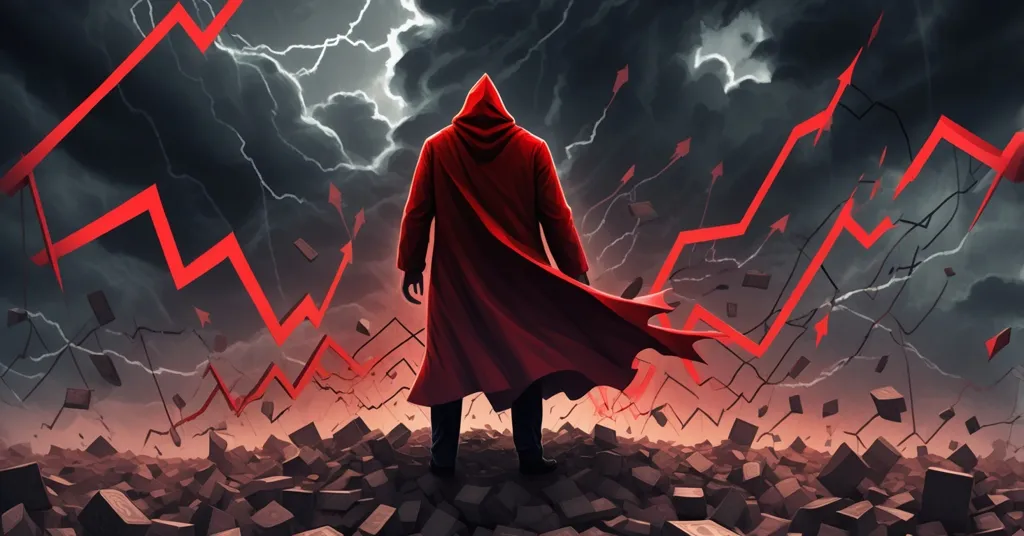Systematic Crypto Dump: Is a Forced Seller Crashing the $3.1T Market?

Systematic Crypto Dump: Is a Massive Forced Seller Tanking the Market?
Is a hidden titan relentlessly unloading assets, dragging the $3.1 trillion crypto market into chaos? Speculation is rife about a major forced seller behind systematic selling patterns following a brutal liquidation shock on October 10, dubbed the “10/10 flush.” Industry voices, including Multicoin Capital’s Tushar Jain, are sounding the alarm on structural cracks still surfacing from that fateful day, shaking confidence in an already volatile space.
- October 10 Shockwave: A massive liquidation event, the “10/10 flush,” ignited cascading sales across the market.
- Forced Seller Mystery: Patterned selling during specific hours points to a large entity in distress.
- Market Vulnerabilities: Over-leveraged portfolios and hidden losses could be fueling the turmoil.
The October 10 Flush: Unpacking the Catalyst
On October 10, the cryptocurrency market endured a seismic jolt, widely referred to as the “10/10 flush.” While exact triggers remain murky, this event saw massive liquidations—forced sales of assets to cover margin calls or insolvent positions—rippling across major exchanges. Think of it as a sudden storm wiping out over-leveraged traders who borrowed heavily to bet on crypto prices, only to be caught off-guard by a sharp dip. Early reports suggest billions in positions were wiped out, though precise data is still emerging. This wasn’t just a blip; it exposed fragility in a market often riding on borrowed money and high-risk bets, setting the stage for the systematic selling we’re witnessing now.
For those new to the space, liquidations happen when a trader’s collateral (the assets backing a loan) drops below a required threshold, forcing platforms to sell off holdings to recover funds. In crypto, where volatility is king, a small price drop can snowball into a cascade of forced sales, especially when players are overextended. The October 10 event, likely exacerbated by macro pressures like rising interest rates or a specific altcoin collapse, left deep wounds that are still bleeding weeks later.
Forced Selling Patterns: Evidence of a Hidden Giant
The aftermath of October 10 hasn’t been a quiet recovery. Instead, market observers have noted eerie, systematic selling—almost robotic in its consistency—particularly during US trading hours. Tushar Jain, co-founder of Multicoin Capital, dropped a bombshell on November 19, suggesting a major forced seller is at play, unloading assets as a direct consequence of the liquidation shock, as detailed in a recent report on a systematic crypto dump. He believes the scale is staggering but likely won’t persist indefinitely.
“It feels like a big forced seller is in the market… we are seeing systematic selling during specific hours… probably a consequence of 10/10 liquidations… Hard to imagine this scale of forced selling continues for much longer.” – Tushar Jain, Multicoin Capital
Echoing this, market commentator LondonCryptoClub described the selling as “constant mechanical,” likening it to unexplained flows in foreign exchange markets that often precede blockbuster revelations of huge mandates. Their grim forecast? A major insolvency—a metaphorical “dead body”—will soon surface, exposing the culprit behind this crypto market dump.
“Increasingly feels like someone out there being forced to liquidate a portfolio… constant mechanical nature of the selling (in US hours)… A dead body will probably float to the surface soon.” – LondonCryptoClub
These patterns aren’t random. They suggest an entity—perhaps a trading firm or market maker—under immense pressure to liquidate holdings to cover losses or insolvent counterparties. It’s a slow bleed, not a panic dump, which makes it all the more unsettling. Even ETF analyst James Seyffart has been crowdsourcing theories on the seller’s identity, but so far, the mystery remains unsolved.
Structural Risks: The Perils of Leverage and Cross-Collateralization
Peeling back the layers, whispers of structural flaws paint a damning picture. On October 12, Andy Klages of The Rollup Co shared rumors of two large trading firms being liquidated to zero. Their portfolios, allegedly worth over $1 billion and consisting of top 100 market cap tokens, were cross-collateralized—essentially, each asset backed the others in a tangled web of debt. When the market turned on October 10, this house of cards collapsed, forcing massive sales into an already spooked market.
Let



